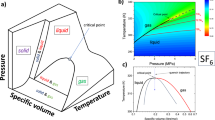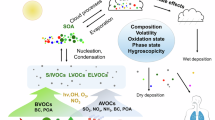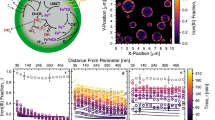Abstract
THE inhomogeneity of fluids at close proximity to their critical point has long been known1,2, well examined3,4 and theoretically explained5,6. The ‘Critical opalescence’ is in fact a two-phase system in the state of fine division, one of the phases being a gas; thus this state may be looked on as an aerosol. This point of view was expressed sixty years ago7. As an aerosol, the near-critical state is a very peculiar one: the specific gravity of the dispersed phase is but slightly different from that of the dispersing medium; the viscosity of the latter is considerably above the usual values for gases.
This is a preview of subscription content, access via your institution
Access options
Subscribe to this journal
Receive 51 print issues and online access
$199.00 per year
only $3.90 per issue
Buy this article
- Purchase on SpringerLink
- Instant access to full article PDF
Prices may be subject to local taxes which are calculated during checkout
Similar content being viewed by others
References
Avenarias, M., Ann. Phys. Chem., 151, 306 (1874).
Altschul, M., Z. phys. Chem., 11, 578 (1893).
Young, S., Proc. Roy. Soc., 78, 262 (1906).
Keesom, W. H., Ann. Phys., 35 (4), 591 (1911).
v. Smoluchovski, M., Ann. Phys., 25 (4), 205 (1908).
Einstein, A., Ann. Phys., 33 (4), 1275 (1910).
Konowalow, D., Ann. Phys., 10 (4), 360 (1903).
Bradley, W. P., Browne, A. W., and Hale, C. F., Phys. Rev., 19, 258 (1904).
Author information
Authors and Affiliations
Rights and permissions
About this article
Cite this article
BENARIE, M. Hypercritical Aerosol. Nature 197, 486 (1963). https://doi.org/10.1038/197486a0
Issue date:
DOI: https://doi.org/10.1038/197486a0



